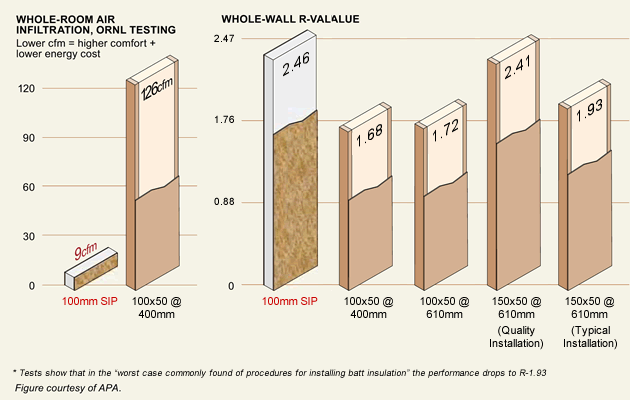Insulation is one of the key components of any energy-efficient home or commercial building. With heating and cooling accounting for 50 percent of energy use in the average home, the type of insulation you choose can save thousands of dollars in utility bills over the life of your home.
Insulation is rated by R-value, which measures a material’s thermal resistance. An insulating material with a higher R-value forms a more effective thermal barrier between the outside temperature and the conditioned space inside the home.
But R-value doesn’t tell the whole story. Laboratory tests that determine R-value have little resemblance to how insulation actually performs in a home. When real world factors such as air infiltration, extreme temperatures and thermal bridging are present, field-installed fiberglass insulation can lose more than half its R-value. Research has repeatedly shown that SIPs provide continuous insulation that will maintain its stated R-value for the life of the home and outperform fiberglass insulation every time.
Download the Premier SIPs R-Value Imperial to Metric Conversion Values PDF

Thermal Bridging
When field-installed insulation is measured in the laboratory, the test only measures the insulation itself, and not the other components that make upthe wall or roof system. Wood-framed homes rely on dimensional lumber, referred to as studs, at regular intervals to provide structural support. Lumber is a very poor insulator and forms a bridge from the outside of the home to the inside of the home where heat can pass through by conduction. This process is known as thermal bridging.
Another issue with field-installed insulation is the installation itself. Fiberglass must be installed between studs and cut to fit around window openings and wiring. This process can never be perfect and leaves gaps where there is no insulation at all.
Oak Ridge National Laboratories has led the building industry in defining whole wall R-value, an increasingly popular metric that tests the thermal resistance of an entire wall section. A 150×50 wall with R-3.35 fiberglass insulation turns out to be R-2.1 when the thermal bridging of studs every 610 inches is considered.
Building with SIPs does not require any insulation to be installed in the field. There is very little dimensional lumber required to build a SIP home because SIPs are structurally sufficient. ORNL tests prove that SIPs maintain their full R-value in whole wall testing.
The Effect of Air Infiltration
The effort to maintain a constant and comfortable temperature inside your home is hampered by two forces: conduction and convection. Conduction is thetransfer of heat through a solid material, which is what insulation is designed to prevent. Convection is the transfer of air through gaps in the walls and roof of the home. Outside air leaking into the home, or air infiltration, is responsible for 40 percent of heat or cooling loss in the average home.
Fiberglass insulation does not protect against air infiltration, as shown in a comparative test conducted by Oak Ridge National Laboratories. Researchers built two identical 242 sq. m. homes, one made of SIPs and one with conventional wood framing and fiberglass insulation. The SIP research home was five times more airtight than the wood-frame room when measured by a blower door test.
SIPs not only serve as a framing and insulation material, but also as a code compliant air barrier. SIP homes have routinely tested two to three times more airtight than wood frame homes with fiberglass insulation.
Air infiltration can cause more problems than just higher utility bills. Air that passes through fiberglass insulation often carries moisture. This can cause unseen mold growth in wall cavities and overall poor indoor air quality that can lead to health problems for occupants.
Laboratory Versus Real World Conditions
In the U.S., the R-value of insulation is determined using a standard testing method called the guarded hot plate test. This test is conducted in a controlled environment, where there is no air movement, at a temperature of 24°C.
Studies conducted by the Department of Energy’s Oak Ridge National Laboratories show that as outside temperatures get colder, the R-value of fiberglass insulation decreases. Using a full scale climate simulator, ORNL tested loose-fill fiberglass attic insulation rated at R-3.35 at a variety of temperatures. When outside temperatures dipped to -22.28°C, the R-3.35 insulation performed at R-1.61. What is more surprising was that infrared imaging revealed convective currents inside the fiberglass insulation. Warm air from inside the house would rise through the insulation, lose heat by coming in contact with the cold attic temperatures, and drop back through the insulation, forming a convective loop of constant energy loss.
In contrast, the rigid foam insulation used in SIPs actually performs better in colder temperatures. Expanded polystyrene with a stated R-value of R 0.6 per inch at 24°C was tested at R-0.74 at per inch at 10°C and R-0.77 per inch at -3.89°C. More importantly, because all types of SIPs have solid insulation completely enclosed with wood sheathing, they are not subject to any convective currents like fiberglass insulation.









